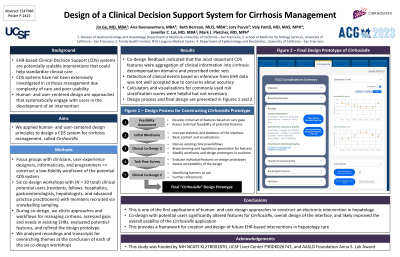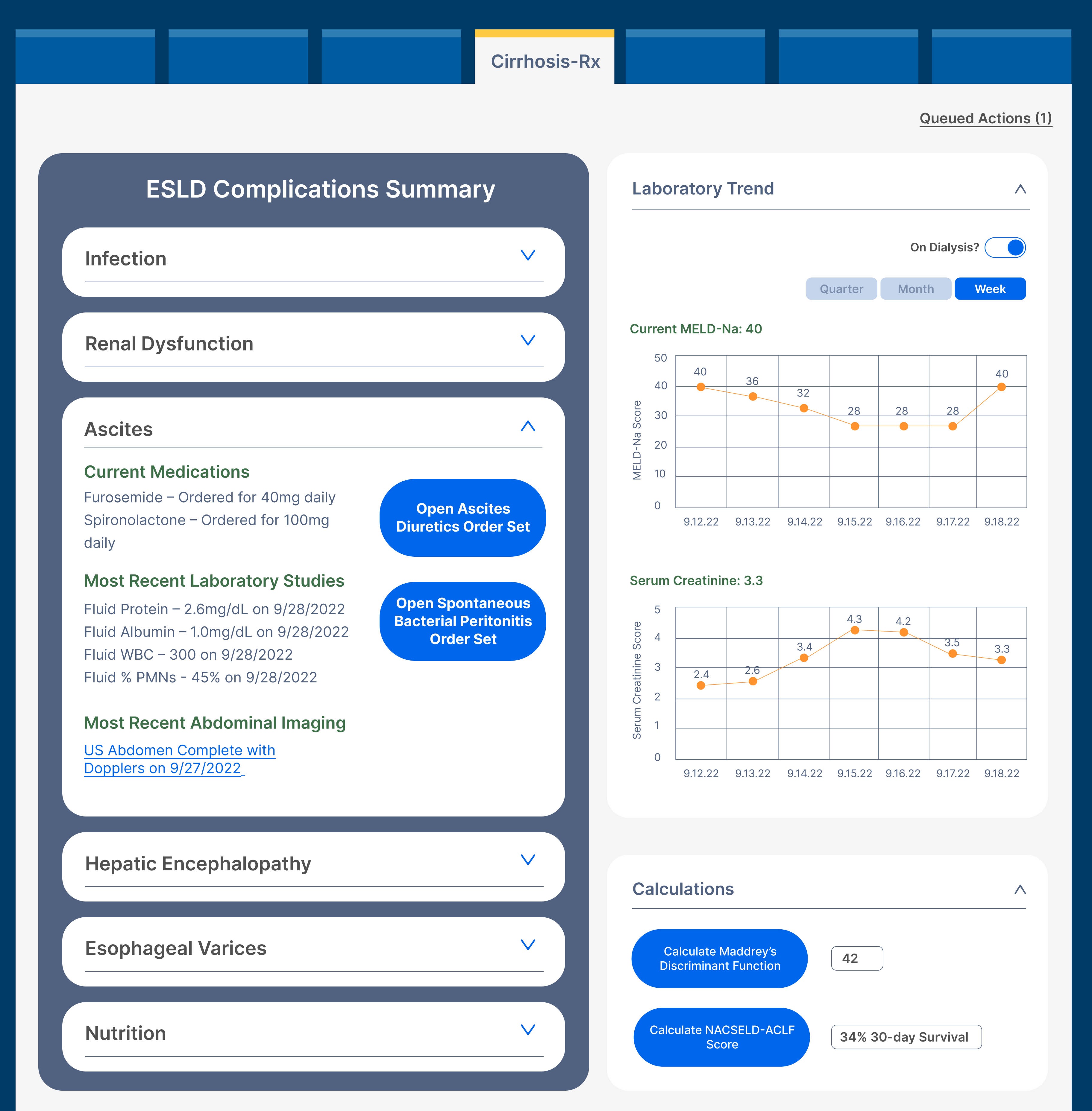Monday Poster Session
Category: Liver
P2415 - Design of a Clinical Decision Support System for Cirrhosis Management
Monday, October 23, 2023
10:30 AM - 4:15 PM PT
Location: Exhibit Hall

Has Audio

Jin Ge, MD, MBA
UCSF
San Francisco, CA
Presenting Author(s)
Jin Ge, MD, MBA1, Ana Buenaventura, BS, MBA1, Beth Berrean, BA, MLIS, DMBA1, Jory Purvis, BS1, Valy Fontil, MD, MAS2, Jennifer C.. Lai, MD, MBA3, Mark J.. Pletcher, MD, MPH1
1UCSF, San Francisco, CA; 2NYU Langone Medical Center, Brooklyn, NY; 3University of California San Francisco, San Francisco, CA
Introduction: Electronic health record (EHR)-based CDS systems are potentially scalable interventions that could help standardize clinical care. CDS systems, however, have not been extensively investigated in liver disease and cirrhosis management. Human-centered and user-centered design are approaches that systematically engage with potential users in the development of an intervention. In this study, we applied principles from these approaches to design a CDS system for cirrhosis management, called CirrhosisRx.
Methods: We conducted initial focus groups that included clinicians, user-experience designers, informaticists, and programmers to construct a low-fidelity wireframe of the potential CDS system. We then convened six co-design workshops with (N = 4-7 per workshop, and N = 20 total) clinicians from diverse practice background (residents, fellows, hospitalists, gastroenterologists, hepatologists, and advanced practice practitioners) via a snowballing sampling method. Practice settings included a major academic medical center, Veterans Administration hospital, and community-based academic inpatient practice. We elicited approaches and workflows for managing patients with cirrhosis, assessed gaps and needs in existing EHR systems, evaluated potential features, and refined the design prototype for CirrhosisRx. At the conclusion of each of the 6 co-design workshops, we analyzed recordings and transcripts for overarching themes.
Results: Feedback from co-design workshops indicated that aggregation of relevant clinical information into cirrhosis decompensation domains and linkages with prescribed order sets were the most important. Detection of clinical events based on inference from EHR data was not well accepted due to concerns about accuracy. Calculators and visualizations for commonly used risk stratification scores, such as MELD, were helpful but not necessary. The final design for CirrhosisRx is in Figure 1.
Discussion: This is one of the first applications of design methods to construct electronic interventions in hepatology. The co-design processes with potential users significantly altered features for CirrhosisRx, overall design of the interface, and likely improved the overall usability of the CirrhosisRx application. This work provides a framework model for the creation and design of future EHR-based interventions in hepatology care.

Disclosures:
Jin Ge, MD, MBA1, Ana Buenaventura, BS, MBA1, Beth Berrean, BA, MLIS, DMBA1, Jory Purvis, BS1, Valy Fontil, MD, MAS2, Jennifer C.. Lai, MD, MBA3, Mark J.. Pletcher, MD, MPH1. P2415 - Design of a Clinical Decision Support System for Cirrhosis Management, ACG 2023 Annual Scientific Meeting Abstracts. Vancouver, BC, Canada: American College of Gastroenterology.
1UCSF, San Francisco, CA; 2NYU Langone Medical Center, Brooklyn, NY; 3University of California San Francisco, San Francisco, CA
Introduction: Electronic health record (EHR)-based CDS systems are potentially scalable interventions that could help standardize clinical care. CDS systems, however, have not been extensively investigated in liver disease and cirrhosis management. Human-centered and user-centered design are approaches that systematically engage with potential users in the development of an intervention. In this study, we applied principles from these approaches to design a CDS system for cirrhosis management, called CirrhosisRx.
Methods: We conducted initial focus groups that included clinicians, user-experience designers, informaticists, and programmers to construct a low-fidelity wireframe of the potential CDS system. We then convened six co-design workshops with (N = 4-7 per workshop, and N = 20 total) clinicians from diverse practice background (residents, fellows, hospitalists, gastroenterologists, hepatologists, and advanced practice practitioners) via a snowballing sampling method. Practice settings included a major academic medical center, Veterans Administration hospital, and community-based academic inpatient practice. We elicited approaches and workflows for managing patients with cirrhosis, assessed gaps and needs in existing EHR systems, evaluated potential features, and refined the design prototype for CirrhosisRx. At the conclusion of each of the 6 co-design workshops, we analyzed recordings and transcripts for overarching themes.
Results: Feedback from co-design workshops indicated that aggregation of relevant clinical information into cirrhosis decompensation domains and linkages with prescribed order sets were the most important. Detection of clinical events based on inference from EHR data was not well accepted due to concerns about accuracy. Calculators and visualizations for commonly used risk stratification scores, such as MELD, were helpful but not necessary. The final design for CirrhosisRx is in Figure 1.
Discussion: This is one of the first applications of design methods to construct electronic interventions in hepatology. The co-design processes with potential users significantly altered features for CirrhosisRx, overall design of the interface, and likely improved the overall usability of the CirrhosisRx application. This work provides a framework model for the creation and design of future EHR-based interventions in hepatology care.

Figure: Figure 1 – Final Design Prototype of “CirrhosisRx”
Disclosures:
Jin Ge: Astellas Pharmaceuticals – Consultant. Merck – Grant/Research Support.
Ana Buenaventura indicated no relevant financial relationships.
Beth Berrean indicated no relevant financial relationships.
Jory Purvis indicated no relevant financial relationships.
Valy Fontil indicated no relevant financial relationships.
Jennifer Lai: Flagship Pioneering – Grant/Research Support. Genfit – Consultant. Novo Nordisk – Advisory Committee/Board Member. Pliant – Grant/Research Support.
Mark Pletcher indicated no relevant financial relationships.
Jin Ge, MD, MBA1, Ana Buenaventura, BS, MBA1, Beth Berrean, BA, MLIS, DMBA1, Jory Purvis, BS1, Valy Fontil, MD, MAS2, Jennifer C.. Lai, MD, MBA3, Mark J.. Pletcher, MD, MPH1. P2415 - Design of a Clinical Decision Support System for Cirrhosis Management, ACG 2023 Annual Scientific Meeting Abstracts. Vancouver, BC, Canada: American College of Gastroenterology.
